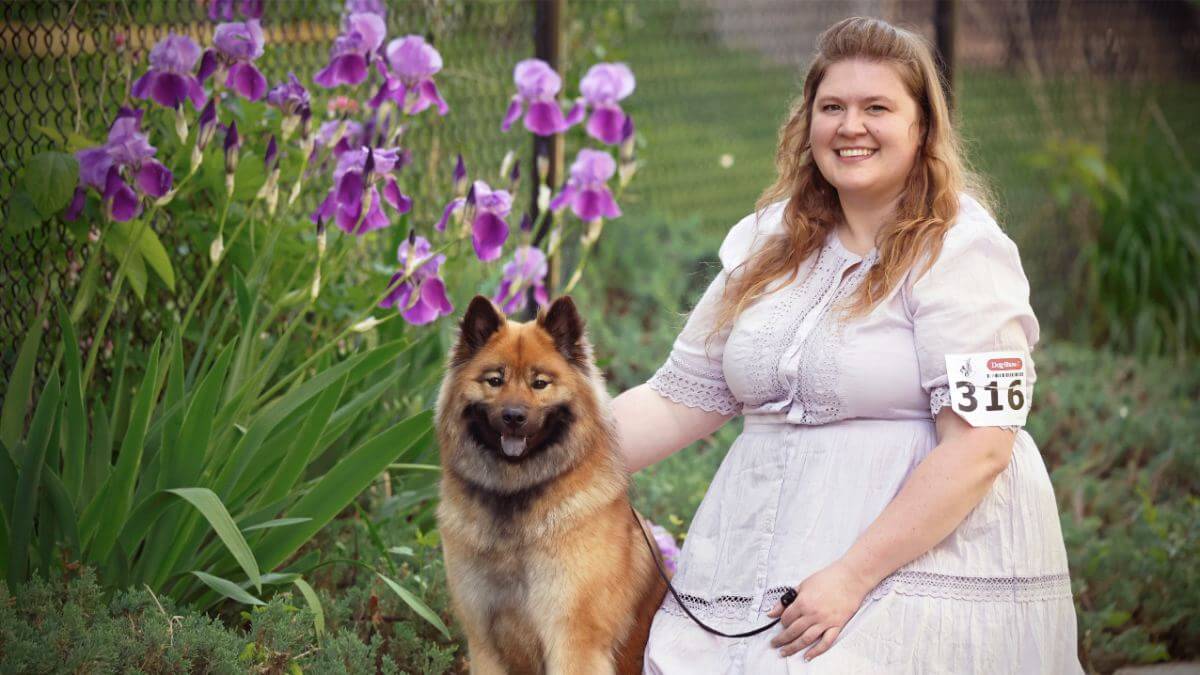
Home » Marissa Armstrong | Cerasi Eurasiers

Marissa Armstrong
1. My name is Marissa Armstrong and I live in British Columbia, Canada. My family has always had purebred dogs of various kinds, but I have been involved with the Eurasier specifically for over 12 years and have been actively exhibiting for about 8 years. I am an active member-breeder of the Eurasier Club of Canada and served as the club’s Secretary for about six years. I had my first litter in 2021 and just recently sent my fourth, the second generation of my kennel, off to their new homes! I am passionate about preserving and promoting this special breed and striving to produce the best in terms of structure, breed type, health, and sound temperament. My kennel name is Cerasi Eurasiers.
2. In a general sense, yes, the breed is in pretty good shape. Most breeders are health testing, and the average lifespan of the Eurasier is quite high, especially for a medium- to large-sized dog. With respect to showing, the Eurasier is not a breed that is commonly shown in North America, so there’s not much in the way of “trends.” However, I believe it would be of benefit to the breed and to the dogs themselves to focus on sound structure while maintaining breed type. In particular, breeding for stronger hocks and stifles.
3. I love showing. I enjoy the competitive aspect and the camaraderie with fellow exhibitors. Being from Canada, I primarily show in CKC events where the Eurasier is fully recognized. That said, the breed is still relatively rare in the show ring, so many judges don’t have much opportunity to get their hands on them. I recently delivered a presentation on the breed to a local judge’s group, and the information was warmly received. So, I think the future is bright for the Eurasier in the show ring as more folks learn about us. I did have the opportunity to attend a couple AKC FSS shows in Washington State and sensed a real fellowship among the FSS/MISC exhibitors. It was lovely and I hope to be back soon! I would love to see more opportunities for FSS breeds to exhibit and be included in larger national AKC events.
4. I think the main challenge for this breed has been interest. For a long while, owners and breeders in the US did not want AKC recognition. I understand where they were coming from, in terms of what popularity can mean for breeds, but as stewards of the breed, I believe it is our responsibility to lead and set the example of how things should be done. As a child who grew up looking forward to watching Westminster on TV every year, I dream, as a breeder, of one day bringing my dog to the green carpet. It still feels far away when the breed has not progressed much in AKC since it was first enrolled in the FSS program over 15 years ago. But I have seen dedicated enthusiasts move their breeds through the program, so I’m sure we can too!
5. I like to be optimistic and say, yes, social media is good for the purebred dog fancy. I co-admin a large Facebook group of purebred fanciers, exhibitors, and breeders, so I often see the negative side of things firsthand. But I see the good as well, and try to promote that among the community. Through social media, I have met other exhibitors, breeders, and stud dog owners around the world that I would otherwise have no way of knowing or connecting with, and have since been able to incorporate their dogs into my lines and share my lines with them. This is especially relevant for a small population breed, where you may not be able to find the qualities you want locally.
6. A few challenges come to mind. We are all struggling to stay afloat these days, so extra expenses for entering and traveling to shows are not in everyone’s budgets. Access to affordable venues for clubs to be able to host shows is also a big one. Another major hurdle is increasingly strict import regulations. It is not easy to bring a puppy into Canada or the US anymore, which will hurt our breeds and show community in the long run. I wish I had solutions to these problems!
7. Continuing from the social media question, I think that some wonderful online communities have been built in the past decade, and especially allowed us to stay connected during the pandemic. In the same vein, we are more easily able to reach the public as well, and educate about ethical breeding and all the different breeds that are out there. We have more access than ever to learn and share knowledge. I have also noticed a big push to be inclusive and welcoming, and calling out negative behavior when we see it happen.